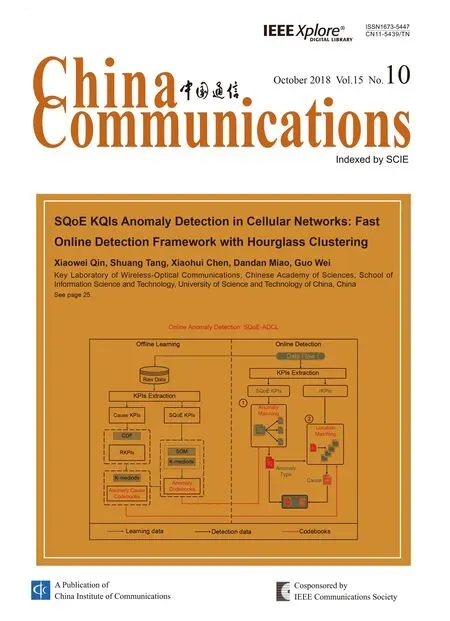ADVANCES IN NETWORK FUNCTION VIRTUALIZATION
In traditional networks, enabling new network functions often needs to add new proprietary middleboxes.However, finding the space and power to accommodate these middleboxes is becoming increasingly difficult,along with the increasing costs of energy and capital investment. Due to the heterogeneous nature of hardware middleboxes, they suffer from long development and upgrading cycles and are hard to scale at peak load.
Network Function Virtualization (NFV) was introduced about in 2012 to address the limitations of dedicated middleboxes and offers the potential for both enhancing service delivery flexibility and reducing overall costs. By leveraging virtualization techniques, network functions are implemented as software that can be deployed on virtual machines, containers, etc. In NFV, network traffic is often required to pass through a sequence of network functions, which is commonly referred to as a service function chain (SFC). NFV has stimulated new types or management philosophy of network services for switching, network monitoring, network security, traffic engineering, QoS / QoE and so on. In the last five years,we have witnessed an explosion of use cases of NFV from both academia and industry in operator networks,data centers, mobile networks, and enterprise networks.Furthermore, NFV has the potential to be widely adopted by advanced fast-growing network environments, such as 5G, wireless networks, and the Internet of Things (IoT).
However, NFV also introduces significant technical challenges that both research and industrial communities need to tackle. Since NFV is based on industry standard hardware (i.e. avoiding any proprietary hardware such as acceleration engines), a probable decrease in performance (latency, jitter, throughput, etc.) has to be taken into account. A consistent management and orchestration platform with significant visibility and operability is also required to fully delivery the management flexibility and scalability of NFV. Furthermore, network operators need to be assured that the security, resilience, and availability of their networks are not impaired when virtualized network functions are introduced. Other challenging issues of NFV include the interoperability, trust, privacy,as well as the migration and co-existence of legacy and compatibility with existing platforms.
In order to stimulate the development and deployment progress of NFV, significant research efforts are needed to fully exploit the potential of NFV to support new service types and next generation networks. Among a number of manuscripts in response to our call for papers, we collected 3 papers in this Feature Topic Issue to showcase recent research and developments related to NFV.
On the NFV management framework side, the first article “An SDN/NFV Based Framework for Management and Deployment of Service Based 5G Core Network”authored by Lu Ma et al. presents a novel management architecture for service-based 5G core network. All the services are implemented based flexible on NFV orchestration to satisfy diverse requirements of users. By using SDN technology, two types of controllers are deployed to respectively manage NFs and flows for enhancing the flexibility and extensibility of 5G core network. Three practical use cases including service guaranteed network slicing, flexible orchestration of network functions and optimal workload allocation in 5G core network are presented to demonstrate the advantages of their proposed framework. Moreover, the workload allocation algorithm is proposed to minimize the bandwidth cost and the energy consumption. The simulation results show the proposed framework and algorithm are effective in terms of reducing network operating cost.
On the NFV service function chain orchestration side,the second article, “Service Function Chain Orchestration across Multiple Clouds” authored by Zhong, Xuxia et.al. studies orchestrating Service Function Chains (SFCs)across multiple data centers in a cost-efficient way. The paper addresses the problem through three steps: SFCs partitions, sub-SFCs consolidation, and SFC-graph deployment. The authors formulate an integer linear programing (ILP) model and propose a meta-heuristic algorithm called CFAO, which contains three modules to tackle the three steps respectively and obtain optimal solutions via iteration. The authors also design heuristic algorithms to deploy SFC-graph in different architectures, including common tree, VL2, and fat-tree, in order to reduce the intra-DC link cost. The experimental results shown in the paper demonstrate that CFAO orchestrates the SFCs in a cost-efficient way.
On the virtual device side, the third article “Accelerating Packet Classification with Counting Bloom Filters for Virtual OpenFlow Switching” authored by Zhao,Jinyuan, et. al. proposes an efficient packet classification algorithm based on counting bloom filters in virtual OpenFlow switches. Counting bloom filters are applied to predict the failures of flow table lookups with great possibilities, and bypass flow table traversals for failed mask probing. The paper first depicts the conceptual framework of packet classification in virtual OpenFlow switching, and offers a profound insight into the packet classification performance bottleneck. Then, the paper optimizes classification performance by predicting the failures of flow table lookups for each packet. Finally, the paper gives the pseudo-code implementation of the algorithm. Experimental results indicate that the proposed algorithm outperforms the classical one in OpenvSwitch in terms of average search length, and contributes to promote virtual OpenFlow switching performance.
We are also grateful to the anonymous reviewers for their timely responses and their valuable comments to improve the quality of the articles. We hope that this Feature Topic Issue will further stimulate research interests in the area of NFV.
- China Communications的其它文章
- A Precise Information Extraction Algorithm for Lane Lines
- Energy-Efficient Multi-UAV Coverage Deployment in UAV Networks: A Game-Theoretic Framework
- An Efficient Algorithm for Skyline Queries in Cloud Computing Environments
- Cryptanalysis of Key Exchange Protocol Based on Tensor Ergodic Problem
- Physical-Layer Encryption in Massive MIMO Systems with Spatial Modulation
- A Robust Energy Efficiency Power Allocation Algorithm in Cognitive Radio Networks

